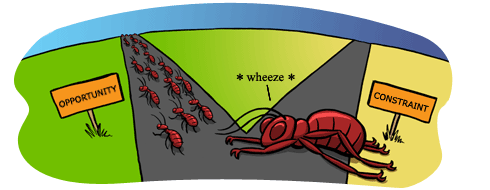Evolution has produced overwhelming diversity (from bacteria to bats) and amazing adaptations (from photosynthesis to echolocation) — but, as you’ve just seen, evolution is not all-powerful. Evolution is an undirected process, constrained by physical laws (such as gravity), by genetics (which might, for example, encode the directions for building breathing organs in a particular way), and by the environment (which might not, for example, contain a niche for a large, slow-moving, and fragile ant). In the case of the arthropods, the exoskeleton — a useful adaptation for body support, protection and water retention — as well as their respiratory system, may have brought evolutionary constraints along with benefits.
Although it’s difficult to know exactly why behemoth ants don’t roam Earth today, you’ve explored several possible evolutionary explanations: the dangers of molting, the structure of the exoskeleton, and the tracheal system. These are artifacts of arthropod evolutionary history and arthropods cannot simply ignore that history and start afresh. The mechanisms of evolution can only work on what already exists. Whatever direction their future evolution leads, it will always be dependent upon the characteristics they inherited from their ancestors.
Now let’s look at a summary of what we’ve learned about evolution and the arthropod.

